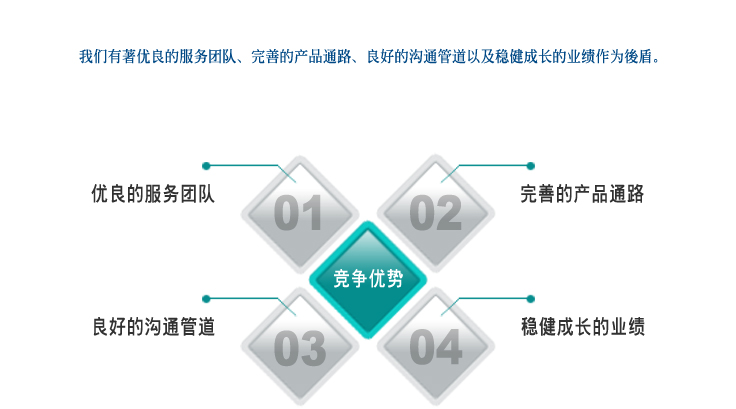基本解釋
起源
他的所有理論都建立在全面細緻的科學調研的基礎之上,極富操作性。從1985年開始出版,《競爭優勢》已重刊35次。此外,競爭優勢的定義是一個企業或國家在某些方面比其他的企業或國家更能帶來利潤或效益的優勢。
理解一
所謂的競爭優勢無非是利用多種多樣的IS以及其他的
Business 工具去獲得更低的成本,更高的利潤。當然這是costly的,也就是說不是大公司很難建立起完善的competitive advantage,所以對於大公司來說,保持
CA是一個非常重要的
business goals;對於其它競爭者,努力獲取CA是一個目標。
理解二
相較於競爭對手擁有的可持續性優勢:優勢資源、先進的運作模式、更適合市場需求的產品和服務。通過上述某個領域或者是多個領域相互作用形成優於對手的核心競爭力。
優勢資源包括:社會資源、人力資源、自然資源、財力資源等,如石油、礦產。
運作模式包括:管理、商業模式、創新力等,如阿里巴巴開創性商業模式。
產品和服務包括:高價值、優勢價格、獨特性等,如
茅台,
麥肯錫諮詢。
英文解釋
Competitive advantage is a position of a company in a competitive landscape that allows the company earning return on investments higher than the cost of investments. Competitive advantage should be relevant, unique, and sustainable.
原文註解
A set of unique features of a company and its products that are perceived by the target market as significant and superior to the competition.
英文: competitive advantage
分類:1. cost competitive advantage
從下面幾方面減少:Experience curves 經驗曲線
Efficient labor 有效率的勞動者
No-frills goods and services 減少包裝
Government subsidies 政府補助
Product design 產品設計
Reengineering 業務流程再設計
Production innovations 產品改良
New methods of service delivery 新的服務傳送方式
2. product/ service differentiation competitive advantage
3. niche stragegies
Competitive advantage is a theory that seeks to address some of the criticisms of comparative advantage.
Michael Porterproposed the theory in 1990. Competitive advantage theory suggests that states and businesses should pursue policies that create high-quality goods to sell at high prices in the market. Porter emphasizes productivity growth as the focus of national strategies. Competitive advantage rests on the notion that cheap labor is ubiquitous and natural resources are not necessary for a good economy. The other theory, comparative advantage can lead countries to specialize in exporting primary goods and raw materials that trap countries in low-wage economies due to terms of trade. Competitive advantage attempts to correct for this issue by stressing maximizing scale economies in goods and services that garner premium prices (Stutz and Warf 2009).
Competitive advantage occurs when an organization acquires or develops an attribute or combination of attributes that allows it to outperform its competitors. These attributes can include access to natural resources, such as high grade ores or inexpensive power, or access to highly trained and skilled personnel human resources. New technologies such as robotics and information technology either to be included as a part of the product, or to assist making it. The term competitive advantage is the ability gained through attributes and resources to perform at a higher level than others in the same industry or market (Christensen and Fahey 1984, Kay 1994, Porter 1980 cited by Chacarbaghi and Lynch 1999, p. 45). The study of such advantage has attracted profound research interest due to contemporary issues regarding superior performance levels of firms in the present competitive market conditions. “A firm is said to have a competitive advantage when it is implementing a value creating strategy not simultaneously being implemented by any current or potential player” (Barney 1991 cited by Clulow et al.2003, p. 221). Successfully implemented strategies will lift a firm to superior performance by facilitating the firm with competitive advantage to outperform current or potential players (Passemard and Calantone 2000, p. 18). To gain competitive advantage a business strategy of a firm manipulates the various resources over which it has direct control and these resources have the ability to generate competitive advantage (Reed and Fillippi 1990 cited by Rijamampianina 2003, p. 362). Superior performance outcomes and superiority in production resources reflects competitive advantage (Day and Wesley 1988 cited by Lau 2002, p. 125).
Above writings signify competitive advantage as the ability to stay ahead of present or potential competition, thus superior performance reached through competitive advantage will ensure market leadership. Also it provides the understanding that resources held by a firm and the business strategy will have a profound impact on generating competitive advantage. Powell (2001, p. 132) views business strategy as the tool that manipulates the resources and create competitive advantage, hence, viable business strategy may not be adequate unless it possess control over unique resources that has the ability to create such a unique advantage. Summarizing the view points, competitive advantage is a key determinant of superior performance and it will ensure survival and prominent placing in the market. Superior performance being the ultimate desired goal of a firm, competitive advantage becomes the foundation highlighting the significant importance to develop same.
基本要素
簡介
(1)先前或已獲得的資源。這裡的資源,是獨特的、競爭對手不具備的資源,並且競爭對手難以複製這種資源。
(2)革新能力。一些公司在革新方面比其他公司有更強的能力,這些公司理所當然具備競爭優勢。革新能力是非常重要的,通過它常常能夠找到獲取競爭優勢的真正突破點,而使競爭者在長期的競爭中處於不利地位。
(3)真正的競爭差距。實際上,任何資源相對於競爭者來說,都存在真正的優勢。僅僅強調識別出存在真正強勢的資源是不夠的,還必須比對手的更具競爭力。比如,僅僅擁有“低成本,高質量”是不夠的,還必須使成本比競爭者的更低,質量比競爭者的更高。
(4)替代能力。如果資源不能被替代,那么它通常就擁有更大的競爭力。有時獨特的資源能夠被全新發明的資源所代替,這種情形一旦出現,競爭優勢就會消失。
(5)合適性。任何一種資源,都必須能夠把它本身的優勢傳遞給公司,而且儘量不能讓競爭對手及他人獲得。資源具備優勢,並不意味著它的所有者將會獲得這一優勢,這就是合適性問題,擁有不是最重要的,最重要的是擁有而且合適。
(6)經久力。有用的資源以及其他競爭優勢,必須能夠持續一定的時期。不具備可持續性的資源是沒有意義的。而且在未來時期內,具有競爭力的優勢通常是不可再生的競爭優勢,比如,柯達所擁有的商標優勢就具有持久力,並且是不可再生的。
(7)模仿力。資源如果具備競爭優勢,就不易被模仿。儘管許多資源最終都會被複製,但可以通過下述途徑延遲被模仿的過程:
①有形的特色。一些特殊形式的差異,例如一種商標,或一個特殊的地理位置,或得到專利的保護,這都將延遲被模仿的過程。
②因果關係的
模糊性。模糊性即不讓競爭者了解是哪種資源創造了競爭力,它對於競爭對手來說是很難學到或者不易獲得的。
③投資障礙。當市場很有限或增長前景不明朗時,如果公司實施的新戰略進行了大規模投資,就能夠很好的阻止競爭者進入該市場,尤其是當推出新產品和新服務需要大量資本或重大的行銷活動時。
套用
該工具主要套用於下列五種情形:
(1)培育競爭優勢時。
(2)研究現有競爭態勢時。
(3)研究競爭對手的優勢時。
(4)制定進攻型戰略時。
(5)制定防衛型戰略時。
戰略類型
2、差異化戰略(Differentiation)
3、通過擴大或收縮這兩項戰略,則形成第三個競爭優勢戰略 - 聚焦集中戰略(Focus)
競爭優勢第一戰略: 成本領先(低成本優勢)
* 實現成本領先,意味著企業成為行業內的低成本製造者。
* 儘管成本領袖依靠低成本實現競爭優勢,但它在價格上也要達到
平價水平,至少也應該結合使用差異化戰略。
* 如果超過一個公司致力於成為行業內的成本領導者,那將是一場災難。
競爭優勢第二戰略: 差異化
* 實現差異化,意味著企業在行業內占據獨一無二、無人取代的地位,並且廣泛地被顧客接受和欣賞。
* 差異化企業也不能忽視其成本地位, 在不影響差異化戰略的情況下, 企業應該儘可能降低成本; 在差異化領域,產品成本應該至少低於企業從買方手中收取的價格
溢價。
* 可以實現差異化的領域有: 產品、渠道、銷售、市場、服務、企業形象,等等。
競爭優勢第三戰略: 聚焦集中
* 實現聚焦集中,意味著企業成為某一細分市場或行業中的最佳企業。
* 兩個變形: 集中成本和集中差異化。
* 力爭中游
o 對於那些利潤績效低於行業平均水平的企業來說,這個方子是開給他們的。
o 只要行業整體水平表現不錯,即便是中游企業的利潤回報也是比較誘人的。
o 企業選擇餘地很小。
o 對那些運用聚焦戰略的企業來說,最危險的事情莫過於成功之後開始忽視他們所聚焦的對象。 他們必須尋找新的聚焦對象, 而不是放任他們的聚焦戰略效能減弱。

